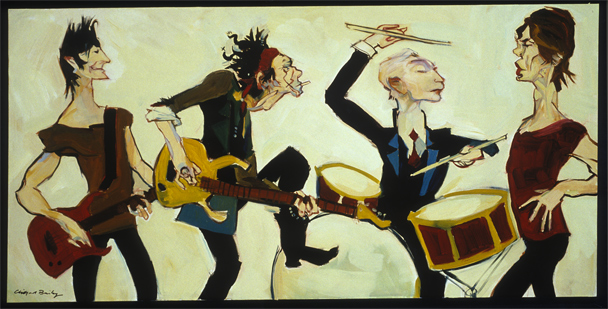Ask anyone who has ever gone on tour with a band about life on the road. Ask them about the sex and the drugs and the rock ‘n’ roll. Go ahead. After they stop laughing, you will probably hear stories of great adventures, discoveries, and camaraderie. Dig deeper, though, and the stories turn darker. The chronic sense of dislocation. The sleep deprivation. The Domino’s.
Not surprisingly, waking up in a tour bus outside an arena in a city you don’t recognize is not made any easier by weak coffee with a stale doughnut chaser. This is the moment where the glamour and romance of the touring life starts to crack. Because before the houselights dim and the crowd screams, before “Hello, Cleveland!” and the guitar solo, there is breakfast.
In the absence of sleep—and on tour, sleep will assuredly be absent—good food is often the crew’s (and the artists’) most reliable tether to comfort, health, and happiness. The headliner can significantly influence the food served to the crew, which can have a palpable effect on the morale of the tour.
When Rod Stewart played the Miami Arena in fall 1993, catering was housed in a windowless room, deep in the bowels of the since demolished stadium. Gray linoleum floors, gray Formica tables, fluorescent lights embedded in a yellowing drop ceiling. It was the kind of break room millions of workers know intimately—a pitiless bunker.
The breakfast spread was typical for an international arena tour: an assortment of breads, jams, eggs, and meat. Lots of coffee. PG Tips tea for the English among the crew, Barry’s for the Irish, Vegemite for the masochists.
One morning, eyes widened and steps quickened as the team neared the steam table. Heaped next to the bangers and eggs was kedgeree. Flaked fish (salt cod, in this case, but commonly made with anything from salmon to finnan haddie) mixed with rice and chopped hard-boiled eggs, seasoned with curry powder. The English say kedgeree came from the Raj, based on the Indian dish kitcheri, a mash of rice and lentils, traditionally eaten at breakfast. The Scottish say that it originated in Scotland, only picking up the curry while in the Subcontinent. This being a Rod Stewart tour, the Scottish-origin story prevails.
For the crew, most of whom hailed from the British Isles, the kedgeree provided a comforting connection to homes and families that they had been away from for months, and might not see for months to come. This is hearty breakfast stuff, made for people who may well miss lunch, engrossed in the intensely technical and physical demands of setting up a concert. It is also an assertion of Stewart’s heritage and identity that reaches far beyond kicking soccer balls into the crowd each evening.
The influence of an artist on a tour’s food does not always guarantee salutary effects on morale, however.
Paul McCartney famously runs a strictly meat-free tour. Potential crew members know about this, and must commit to a vegetarian diet before signing on. Paul’s tour, Paul’s rules. Don’t like it? Maybe Metallica’s hiring.
Aside from coming home healthier than they left, McCartney’s crew is known for getting some of the best vegetarian cooking anywhere. On any given night, dinner might include celeriac, chestnut, and pesto soup; sweet potato gnocchi with spinach-and–blue cheese sauce; a meatless Irish stew in puff pastry with colcannon; and no shortage of desserts. However good the catering, though—and however righteous the cause—the shift to tofu and tempeh can still be jarring for the average carnivorous crew member. Pockets of rebellion are all but inevitable.
Over the years, some crew have risked (and, according to a 2007 Waco Tribune-Herald column by rocker Ted Nugent, lost) coveted positions on such a high-profile tour as this for the sake of contraband meat. They forgot the first rule of the Hamburger Club: You don’t talk about the Hamburger Club. In cases like this, diet trumps all else—jobs, reputations, and morale are risked for food.
Sometimes though, the food on the plate is secondary. The act of taking a meal together, far from home, can be enough to stave off misery and desperation.
Thanksgiving 1989 found the Ramones playing the Biskuithalle in Bonn, Germany. The capital of West Germany at the time, Bonn was, as John Le Carré called it, “a Balkan city, stained and secret, drawn over with tramwire.” Without the illicit wonders of Hamburg, or the Cold War frisson of Berlin, Bonn provided few distractions for a punk band far from home. After a decade and a half with the group, tour manager Monte A. Melnick knew his charges well. It was at just these times—in the places in between, when everyone would rather be home—that TVs might find their way into hotel pools, and apologies and restitution risked becoming part of hotel checkout.
Melnick made a valiant attempt to arrange a traditional Thanksgiving dinner for the band and crew. “It could be hard explaining to a caterer in Europe what Thanksgiving was all about. In Germany, they didn’t really get it, but they tried.” The menu was a disappointment, to be sure, but with a decade and a half of hard touring behind them, the Ramones and crew were no strangers to Thanksgivings on the road. As it was, comfort was almost anathema to the band’s ethic; long after they could afford to travel by luxury coach, they stuck to the van. The Ramones were always about the wanting and not the having—still, what mattered was the effort to satisfy those wants. That attempt to ensure the gang’s welfare and happiness with a decent holiday dinner reinforced a bond that lasted through the group’s entire career.



 Pinterest
Pinterest


